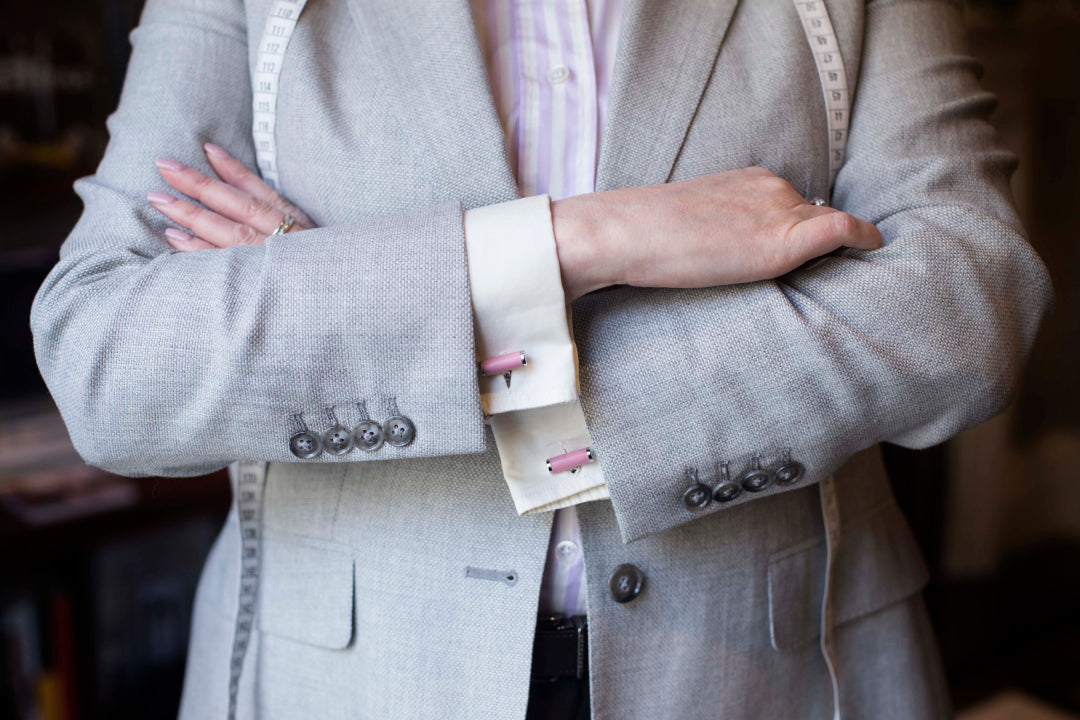The Ettinger Journal talks to Savile Row’s first female master tailor and Britains most successful woman tailor, Kathyrn Sargent.

Dressed in a striking checked plum blazer and fresh from a Walpole trip to New York, Kathyrn Sargent is every inch the British luxury ambassador when we visit her at her Mayfair studio. Traditional leather-topped cutting boards, strewn with scissors and panels of rich cashmere tweed, contrast the elegant champagne sofas and clean mid-century coffee table in the reception area of her showroom. Jacketed mannequins, mostly female, fill the windows in this neutral, glossy space. And seated in an armchair by the window, legs crossed to display her ochre velvet slippers, sits the First Lady of Tailoring herself.
“I was the first woman master tailor and the first woman to set up on Savile Row with my name above the door,” says Sargent. It was a Harris Tweed suit she created for her graduate fashion show in 1996 that propelled her into a job at traditional Savile Row house, Gieves and Hawkes. During 15 years with the traditional house, Sargent worked her way up to the position of Head Cutter, something never achieved by a woman before, and then struck out on her own. Initially, she took a ‘board’ in a communal working space on Savile Row before progressing to a ‘seasonal store’ and then to her shop in Mayfair, which she moved to five years ago.
So, is tailoring still a man’s world? “Absolutely, but it’s worth remembering that the majority of tailoring house clients are men,” explains Sargent says. “My dad would never let me get near him with a tape measure so I do understand that it’s a generational thing,” she adds. “It’s evolution, not revolution.” But fortunately (both for women in tailoring and women wanting top-class bespoke pieces), things are changing. And Sargent is leading by example: Kathryn employs three women, including her principal coat maker, Rachel Roberts, who stands in the less-polished ‘workshop’ section of the studio, her thimble finger pushing a needle through a tacked-together navy jacket. The amount of hand sewing involved in each piece is phenomenal when you see it first-hand.

Sargent also designs for women as well as with them, a fact that’s immediately evident as she takes me through the bulging ‘work in progress’ cabinet. “Women often go more for the ultimate jacket or coat if they want something tailored,” says Sargent. “Some want mix and match pieces for their wardrobe and some are smart business women who might wear a trouser suit every day for work,” she adds, showing me a striped suit with a wide leg trouser, a navy suit that’s ready for fitting, and a fine velvet suit, all for women. “Other tailors don’t offer the same thing,” she explains of her foray into ladies’ tailoring.
Although the women’s market is growing – it currently makes up 30% of Sargent’s business - she still makes the majority of her garments for men. “Essentially, whether designing for women or men, I want to re-examine the word bespoke – taking a really modern approach to a traditional value,” says Sargent. “Many houses have a set way of doing things, but we work with each client to create something really unique and special. I have no house style. I work more to the individual.” Sargent explains the importance of client psychology to her creative process: a listening ear; the right questions and careful research are almost as essential to Sargent as scissors and thread. “Once you’ve made a few pieces for people you know them so well that you begin to recommend things to them, such as cloths or styles. You get to know someone’s real absolute taste.” Tailoring, these days, is about sartorial advice as much as sewing.
As part of this process, Sargent looks at which items her male clients carry in their pockets. “We take measurement of clients and look at what they are carrying - sometimes we will advise them to go and buy a more slim line wallet. It’s no good if you’ve got a beautiful coat and then a massive, chunky wallet,” says Sargent, who adds custom sized and cleverly positioned pockets to her suiting, depending on what’s to be carried. “I would suggest something narrow but slim,” she explains. “Perhaps a small wallet for your essential cards and a long coat wallet in addition - think thin.”
And what’s next for suiting? “The younger generation is getting much more playful with cloths, cuts and fabrics,” she explains, before describing the cloths with diamond chips or gold thread that are now available. A book of bright striped fabrics inspired by Salvador Dali, from Scabal, lies next to the books on the coffee table. “The young are also much more into formal styles than they were ten years ago – double breasted suits are seeing a comeback,” she adds.
And in light of the younger demographic’s renewed interest in suiting, Sargent has shrewdly launched her ‘crafted’ made-to-measure range, with a faster pace of production and a keener price than for her bespoke pieces. With that and the growing women’s wear market catered for, the First-Lady of Tailoring seems to be operating a cut above the competition.


